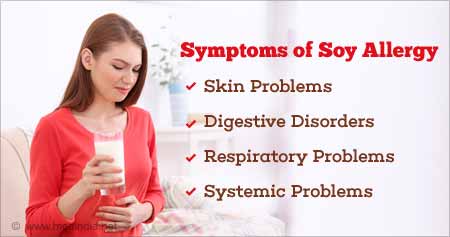Soybean allergy is mostly seen in babies and children, affecting 0.4 percent of children. However, the majority of children with soybean allergy develop tolerance in early childhood. Research shows that 50 percent of affected children outgrow their allergy by the time they are 7 years of age. Soy allergy symptoms range from mild rashes to life-threatening whole body allergic reaction. Soybean allergy symptoms, like those of other allergies, are mainly of four types
1. Dermatological
2. Gastrointestinal
3. Respiratory
4. Systemic. It is very important that you seek immediate medical attention in case of anaphylaxis, as it can be fatal if not treated on time. Death occurs because the heart cannot supply the oxygen required by the body. This is referred to as cardiovascular collapse. Anaphylaxis also causes the throat to swell up, making it difficult to breathe in oxygen. Soy allergy can be diagnosed with the help of two tests-
Skin test: Here, your doctor will inject a small amount of soy protein by pricking your skin. If you are allergic to soy, you’ll develop hives (rashes) on the skin where you were pricked. Blood test: A blood test can determine the amount of antibodies, IGE, present in your bloodstream. This helps measure your immune system’s response to soy. Soy Allergy Diet It is interesting to note that almost 60 percent of foods contain soy in one or the other form. You can consume soybean in the form of grains, flour, soy milk, soybean oil, and in foods as lecithin (emulsifier) and texturized vegetable proteins. You will find it in bread, cakes and other bakery products, processed foods, and even in baby foods! It is easy to see why it is so difficult to avoid the soy. Foods to Eat So, what to eat if you are allergic to soy? Here’s a list of foods that are safe. Breads and grains that do not contain soy or soy milk; oatmeal and cream of wheat Rice, potato, sweet potato, soy free macaroni, pasta and noodle. Fresh fruits and vegetables; dried fruits, canned and frozen fruits and vegetables. Foods to Avoid, tempeh, tofu, soy sauce, soy margarine, soy infant formula, soy milk, and soy desserts are obviously soy foods. AVOID these if you are allergic to soy. Foods that may contain soy are breads, cakes, biscuits, breakfast cereals, Chinese foods, Oriental style vegetables or foods cooked in sauces, chocolates, dessert mix, ice cream, margarine, mayonnaise, canned soups, processed meats, pasta and pizza bases, most sauces, and snack bars. Before you buy these foods, ensure that they don’t contain soy or soy products. Soy Free
Recipes Chicken salad Ingridients
- 2 cooked chicken breasts One-fourth cup homemade mayonnaise Half cup dried apricots Little water chestnuts
- 1 tablespoon each of (whole or powdered) coriander, cumin, fennel, cardamom and pepper Salt, to taste two tsp vegetable oil one medium sliced onion two cloves garlic,
- 1 tablespoon chopped ginger one tsp each of ground cumin and curry powder one large sweet potato, peeled and diced two cups dried lentils four cups vegetable broth two tablespoons tomato paste
- 5 ounce baby spinach or regular spinach Salt to taste.



You must be logged in to post a comment.